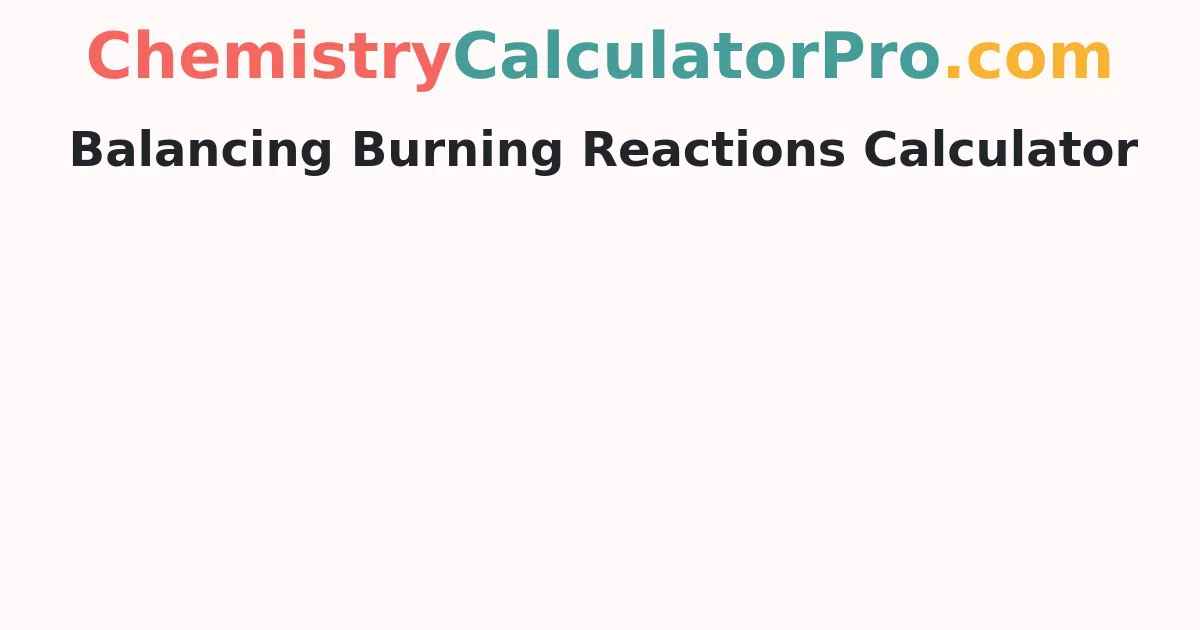Balancing Burning Reactions Calculator
Learn how to balance out burning reactions using the quick online Balancing Burning Reactions Calculator. Just enter the chemical burning equation in the tool and tap on the calculate button to get the balanced burning reaction in the blink of an eye.
What is Burning Reaction?
A burning reaction occurs when fuel is oxidized by reacting with an oxidizing agent, releasing energy (usually in the form of heat). Burning reactions are redox reactions involving an oxidant and a fuel that are often very exothermic. Usually, the oxidized fuel is the end product of a combustion reaction (which is mostly liberated in the gaseous state). The term "smoke" is commonly used to describe this. Flames are frequently seen accompanying combustion processes. However, not all combustion processes result in fires.
Endothermal pyrolysis is a process that produces gaseous fuels from solid fuels like coal and wood. The heat required to drive more combustion is understood to be provided by the combustion of these gaseous fuels. Furthermore, combustion can be intense enough to produce incandescent light in the form of a flame or flickering. Burning can be considered as a simple example of the transition of hydrogen and oxygen into water vapor, which is commonly utilized to fuel rocket engines. The fuel is hydrogen, while the oxidizing agent is oxygen. Per mole of fuel subjected to burning, this burning reaction produces over 242 kilojoules of heat.
Examples of Burning Reactions in our Daily Lives
The following are some common examples of combustion reactions that occur frequently in people's daily lives.
- The burning of LPG fuel in gas stoves for food preparation requires an interaction between the oxygen in the atmosphere and the liquefied petroleum gas.
- The burning reaction between petrol (or diesel) and oxygen provides power to the engines of cars, motorcycles, and other fossil-fuel-powered vehicles.
- Matchstick illumination is similarly based on a combustion process. By striking the matchstick on a rough surface, the red phosphorus at the tip is heated, igniting a combustion process between the phosphorus and the oxygen in the air.
- A burning process is also present in the explosion of fireworks. Certain particular ions are integrated into the fuel in these redox processes to give the flame color.
Many more types of burning reactions are used in a variety of sectors in addition to these basic ones. For example, the space industry is recognized for using the hydrogen-oxygen burning reaction to provide clean energy in rocket ships.
Important Burning Reaction Chemical Equations
The chemical formulae for some of the most important Burning processes are listed below.
Methanol burning (also known as 'wood alcohol') is the result of a chemical reaction between methanol and oxygen. This reaction's chemical equation is as follows:
2CH3OH + 3O2 → 4H2O + 2CO2
Methane's burning processes are known to produce water and carbon dioxide as byproducts. This reaction can be represented chemically using the equation below:
CH4 + 2O2 → 2H2O + CO2
The chemical equation for propane combustion, which is extensively used in culinary sets such as fire grills, is as follows:
2C3H8 + 7O2 → 8H2O + 6CO2
The burning of ethane is another major Burning reaction involving the oxidation of a hydrocarbon. Below is the chemical equation for the reaction between methane and oxygen, which produces carbon dioxide and water.
2C2H6 + 7O2 → 6H2O + 4CO2
Naphthalene also burns in the presence of oxygen, producing carbon dioxide gas and water. The chemical equation for this reaction is as follows:
12O2 + C10H8 → 4H2O + 10CO2
FAQs on Balancing Burning Reaction
1. Is burning an endothermic or an exothermic process?
In general, Burning is an exothermic reaction in which energy is expelled or given off. During a Burning reaction, heat and light are usually released.
2. What is the purpose of oxygen in burning?
The chemical activities that occur during a fire are supported by oxygen. When fuel burns, it reacts with oxygen in the air around it, producing heat and Burning products (gases, smoke, embers, etc.).
3. What is the meaning of a complete burning reaction?
When the fuel is entirely oxidized, complete burning reactions, also known as clean-burning reactions, occur (usually a hydrocarbon). The only products of such reactions are often water and carbon dioxide. A good example of a clean combustion reaction is the burning of wax candles. Wax is a hydrocarbon that produces just carbon dioxide and a little amount of water as a byproduct when burned properly. It's also worth mentioning that no ash or byproducts are left behind when the candle is entirely burned out.
4. What are incomplete burning reactions, and how do they happen?
Incomplete Burning Reactions (also known as "dirty" Burning Reactions) are combustion processes that produce by-products such as ash and soot. As a consequence of such combustion events, carbon monoxide (a very dangerous gas with the chemical formula CO) is regularly emitted.
